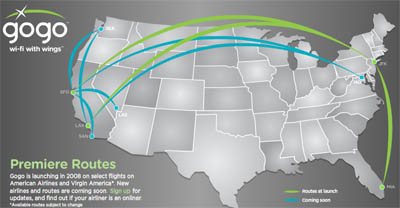In-flight Internet cleared for take-off

I've been skeptical of plans for in-flight broadband access. Let's face it, the airlines don't have a great track record here. No one used those sad phones in the seatbacks. And Boeing's Connexion service--once offered by a few international carriers--is gone. But this time it may finally happen.
In the past few months several U.S airlines--Alaska Air, American Airlines, Continental, JetBlue, Southwest and Virgin America--have announced plans to offer Internet access on some routes. Why now? The equipment is cheaper and easier to install, business and leisure travelers are asking for it, and the Open Skies rules, which are about to go into effect, will suddenly give U.S. airlines more competition. Each airline is taking a different approach to the technology, features and pricing.

American Airlines and Virgin America will both offer Aircell's gogo service, a cellular system that uses a version of EV-DO Rev A to deliver broadband speeds of 2Mbps on flights over North America. Aircell says the basic pricing will be about $12.95 for cross-country trips and $9.95 for flights lasting three hours or less. Starting this spring, American will outfit 15 of its Boeing 767s for gogo. It plans to target business travelers with laptops on popular routes between New York and San Francisco, Los Angeles, and Miami. Virgin America is taking a different approach. It hopes to offer gogo on all flights and for all passengers via the entertainment system in the seatbacks. No laptop required.
JetBlue already offers free Internet access, but it is only a "BetaBlue" trial on a single Airbus A320. You can use Yahoo Mail or Yahoo Messenger, and check corporate e-mail if you happen to use a BlackBerry with Wi-Fi such as the BlackBerry Curve 8820 or Curve 8320. But that's about it--at least for now. And it only works over the continental U.S. Provided by JetBlue's LiveTV subsidiary, the service is also a cellular system built on some of the same spectrum as those lonely Airfones. Continental will also use LiveTV to offer satellite TV and Internet access on domestic flights beginning in early 2009. Some LiveTV services are also available on WestJet, Frontier, Virgin Blue and AirTran.
Finally, there's Row 44. Like Boeing's Connexion, Row 44 is a satellite service that should also work over oceans and on international flights, though the company is focused first on North America. Alaska Airlines will start trials using Row 44's service on some flights as early as the second quarter of 2008. And in January Southwest said it would test Internet access with Row 44 on four Boeing 737s starting this summer.
Of course there are still a few hurdles. Because electronic devices can interfere with flight equipment, many regulatory agencies still prohibit voice or data communications while aloft. Technology can solve that problem.
Another big concern: Passengers can use VoIP clients such as Skype to make calls, disrupting their neighbors. American and Alaska Air recently told The New York Times that they will block VoIP calls, but Virgin America isn't ruling it out, and international carriers such as Air France are already experimenting with mobile phone use during flights. Some frequent fliers are adamantly opposed to this, but I'd gladly deal with the occasional voice call in exchange for decent broadband access at 30,000 feet.
- U.S. In-flight Broadband Is A-gogo by Spring [GigaOM]
- Web Access and E-Mail on Flights [NYT; registration required]
- Airlines Look for Ways To Provide Wireless Services [WSJ.com; subscription required]
- Continental to Add Wi-Fi, Satellite TV to Some Planes [WSJ.com]
- AMR to Test Wi-Fi Service For 767 Planes [WSJ.com]
- Cellular Flies High: Airlines Test Cruising-Altitude Text Messages, Calls [WSJ.com]
- The Airborne Net: Internet Access Could Be Handy on Airlines, But It Also Removes a Digital-Age Sanctuary [WSJ.com]